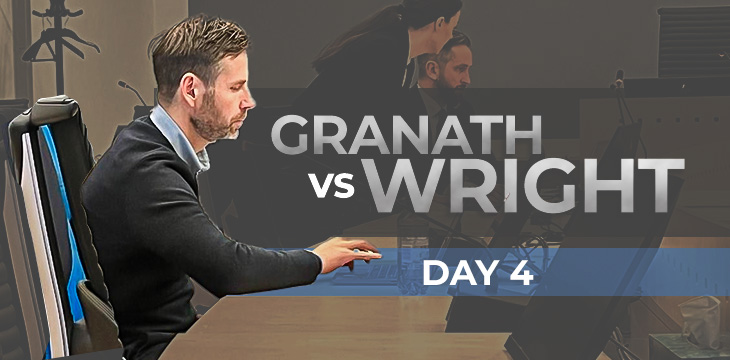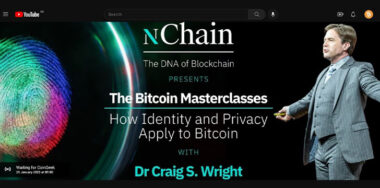The Granath v Wright trial continued Thursday, with former colleagues of Dr. Craig Wright testifying that he had been talking about the concepts that would become Bitcoin for years before it was released—with one even being given a draft of the white paper in early 2008.
Stefan Matthews was one: though he’s currently chairman of nChain, he met Dr. Wright in the mid 2000s when working for online gaming company CentreBet. The company contracted BDO to do a systems control audit on the company and Wright was the audit lead. Matthews said that his team was highly impressed by Dr. Wright’s work, but most importantly over the course of their working relationship in 2007 and 2008, Wright talked with Matthews at length about an electronic cash project he was working on. This culminated in Wright handing Matthews a hard copy of a draft Bitcoin white paper before it had been released anywhere publicly. Matthews remembers it didn’t have the Satoshi Nakamoto name on it, but recalled that when he later read the final version of the white paper years later, “it was like I’d seen a ghost”: it was the paper Wright had given him years before.
Matthews also corroborated much of Dr. Wright’s testimony on Day 3 of the trial. He said that Dr. Wright was unhappy with the idea that he would need to prove his identity, and that in particular the idea of signing messages with Satoshi’s keys as a means of doing so was antithetical with his own beliefs: that keys do not prove identity. Nonetheless, the Wired/Gizmodo leaks put an enormous amount of pressure on Wright which placed him on a course toward the so-called signing experiments in early 2016.
Matthews also testified that just eight weeks earlier, he had met with Jon Matonis, the first person to witness Wright’s successful signing demonstration using Satoshi’s keys. He confirmed to Matthews that he stands by his belief that Dr. Wright successfully signed a message using Satoshi Nakamoto’s private keys.
Another was Rob Jenkins, an IT consultant who met Dr. Wright while working at Vodafone. Vodafone contracted Dr. Wright’s company, DeMorgan, to design the company’s firewall system. Jenkins was effusive in his praise for Wright’s technical skills, saying the system Dr. Wright ultimately designed for them was the best he’s ever seen, before or since. Like Matthews, Jenkins said he formed a relationship with Wright around the work they were doing together.
Also like Matthews, Jenkins says that Wright talked with him about many of the concepts that were considered so important and novel upon the white paper’s release. They discussed things such as whether you can trust your bank, the concept of money, immutable ledgers, whether you could replace the financial system with technology and the concept of a ledger that would replicate across multiple systems. Though Bitcoin was never mentioned, the ability to transfer value from one point to another on a trustless basis using nodes with their own security was discussed.
The conversations left such an impression on Jenkins that when Wright was outed as Satoshi in 2015, he felt it was ‘without a doubt’ feasible that Wright was Satoshi based on their conversations.
Hal: Any relevant topics?
Rob: Always tech, banking, finance. He'd ask if I trust my bank to hold my money lol. Fiat currency…
Hal: what's that?
Rob: It's currency not backed by physical gold, in a basic sense.
Hal: Fiat is central banked?
Rob: Yes, no backing— Kurt Wuckert Jr 🟡 GorillaPool.com (@kurtwuckertjr) September 15, 2022
The testimonies are an apt follow up to Dr. Wright’s time on the stand on Wednesday, when he told the court that mere private keys associated with Satoshi Nakamoto cannot prove identity, and that he had chosen the difficult but ultimately only truly effective route: relying on a body of evidence which included ’70-100’ witnesses who could attest to Wright’s authorship of the white paper first-hand. Today, it appears the world saw the first of those witnesses.
There were also three witnesses put up by Granath.
These were Torbjorn Bull Jenssen, CEO of Arcane Crypto; Johan Toras Halseth, technology director of Firi and former Lightning Labs protocol engineer; and Svein Olnes, senior researcher at Vestlandfordking and a tenured academic.
All agreed that Dr. Wright’s supposed proofs—either to Matonis and Andresen or the May 2016 blog posts—were unsatisfactory. Olnes said that Wright is far from what he imagined Satoshi to be, calling him pompous with a ‘concealing’ way of communication. Halseth said that when he read the 2016 Sartre blog post, he felt it was very clear that it’s trying to do something technically simple in a complicated way—and that maybe the purpose was the mislead the reader.
Over time, the quality of bitcoin thought from BTC people has dropped dramatically.
All 3 defense witnesses today were just so utterly basic. Nobody understood the Sartre riddle. The guy focused on the Sartre blog didn’t even know who Sartre was!! https://t.co/TFaqB4l3u2
— Kurt Wuckert Jr 🟡 GorillaPool.com (@kurtwuckertjr) September 15, 2022
However, they were also asked about Granath’s tweets, and broadly whether the language used within them was as ubiquitous within digital asset communities as Granath alluded to in his testimony. None of the witnesses could endorse the tweets: Jenssen said the language was not what he would be happy using, and when asked if it was possible to be part of the conversation surrounding Wright without resorted to such language, he said “absolutely.”
The trial continues with more witnesses from both sides on Friday.
Watch: Granath vs Wright Satoshi Norway Trial Coverage Livestream Day 4
New to blockchain? Check out CoinGeek’s Blockchain for Beginners section, the ultimate resource guide to learn more about blockchain technology.









